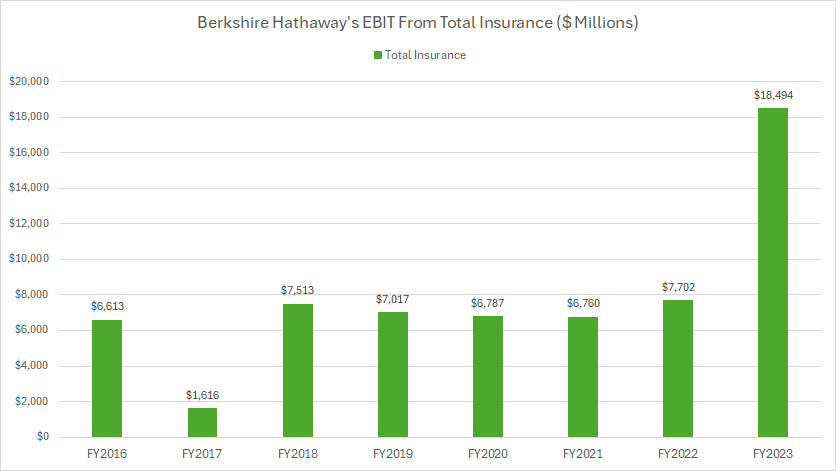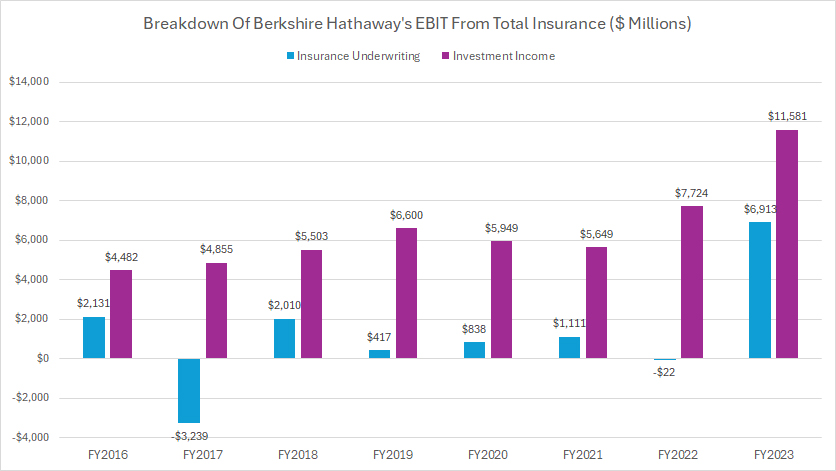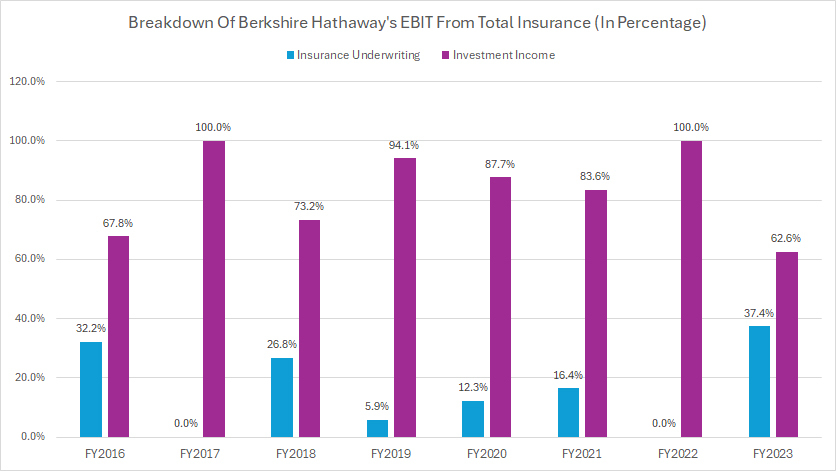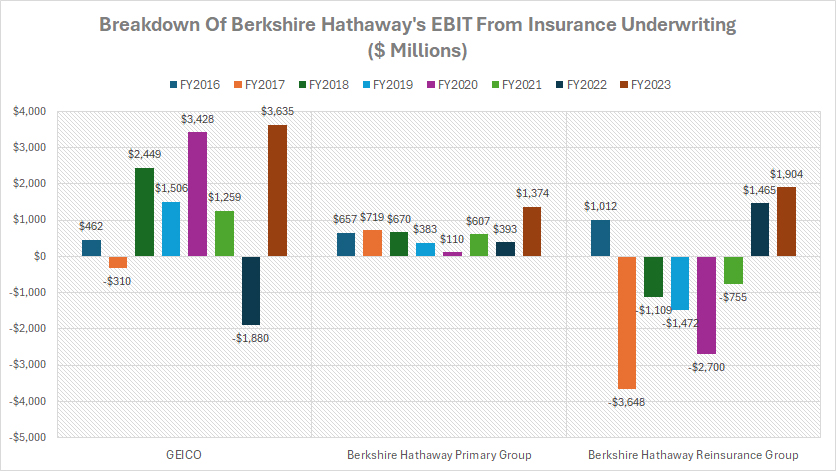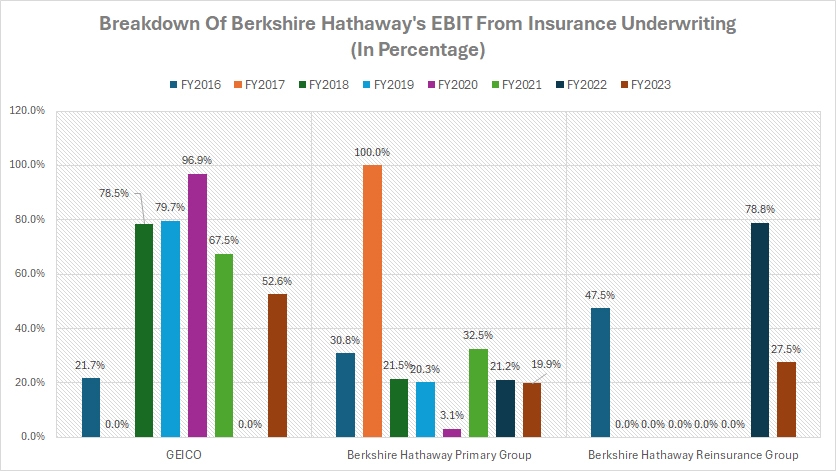
Property. Pexels Image.
This article provides a detailed breakdown of Berkshire Hathaway’s profitability within its insurance segment, categorized by divisions such as GEICO, the Primary Group, and the Reinsurance Group.
For the definitions of Berkshire’s insurance divisions, you may visit this section: Berkshire’s insurance segments.
Let’s take a look! You may find related statistic of Berkshire Hathaway on these pages:
- Berkshire Hathaway insurance profit margin,
- Berkshire Hathaway insurance revenue by division, and
- Berkshire Hathaway revenue breakdown.
Please use the table of contents to navigate this page.
Table Of Contents
Definitions And Overview
- Insurance Underwriting
- Investment Income
- GEICO
- Berkshire Hathaway Primary Group
- Berkshire Hathaway Reinsurance Group
- Earnings Before Income Taxes (EBIT)
O2. What may cause a loss in Berkshire’s insurance business?
Consolidated Profit For Insurance
A1. Total Profit From Insurance
Profit Breakdown
B1. Profit From Insurance Underwriting And Investment Income
B2. Profit From Insurance Underwriting And Investment Income In Percentage
Breakdown Of Profit From Underwriting
C1. Profit From GEICO, Primary Group, And Reinsurance Group
C2. Profit From GEICO, Primary Group, And Reinsurance Group In Percentage
Summary And Reference
S1. Summary
S2. References and Credits
S3. Disclosure
Definitions
To help readers understand the content better, the following terms and glossaries have been provided.
Insurance Underwriting: Insurance underwriting is the process by which an insurance company evaluates the risks associated with insuring a person, property, or entity and determines the terms and conditions of the insurance policy.
This process helps the insurer decide whether to provide coverage and at what premium rate. Here are the key steps involved in insurance underwriting:
- Risk Assessment: Underwriters assess the potential risk factors associated with the applicant. This may include reviewing the applicant’s health, occupation, lifestyle, or the characteristics of the property being insured.
- Application Review: The underwriter examines the information provided in the insurance application, including any supporting documents, such as medical records or property appraisals.
- Data Analysis: Underwriters use statistical data, historical claims information, and other relevant data to estimate the likelihood of a claim being made and the potential cost of that claim.
- Decision Making: Based on the risk assessment and data analysis, the underwriter decides whether to approve or deny the insurance application. If approved, they determine the policy terms, coverage limits, exclusions, and the premium rate.
- Policy Issuance: Once the terms are agreed upon, the insurance policy is issued to the applicant, outlining the coverage details and the conditions under which claims will be paid.
Insurance underwriting ensures that the insurer can manage its risk portfolio effectively while providing appropriate coverage to policyholders.
Investment Income: Berkshire Hathaway’s investment income refers to the earnings generated from the investments made by its insurance subsidiaries, as well as other segments of the company. Here’s an overview:
- Insurance Float: Berkshire Hathaway’s insurance operations, such as GEICO and Berkshire Hathaway Reinsurance Group, collect premiums from policyholders. This pool of funds, known as “float,” represents money that the company holds until claims are paid out. Warren Buffett and his team invest this float in various financial assets to generate returns.
- Equity Investments: Berkshire Hathaway holds significant positions in publicly traded companies. These equity investments generate income through dividends and capital appreciation. Notable investments include large stakes in companies like Apple, Coca-Cola, and American Express.
- Fixed-Income Investments: The company also invests in fixed-income securities, such as bonds and Treasury bills. These investments provide regular interest income, contributing to the overall investment income.
- Private Investments: Berkshire Hathaway makes investments in private companies and businesses, often acquiring them outright. These investments contribute to the company’s investment income through dividends, interest, and the profits generated by these businesses.
- Real Estate Investments: Berkshire Hathaway invests in real estate properties, both directly and through its subsidiaries. These properties generate rental income and potential capital gains.
Overall, Berkshire Hathaway’s investment income is a critical component of its financial performance, allowing the company to leverage its insurance float and other capital to generate substantial returns.
GEICO: Berkshire Hathaway’s GEICO, also known as the Government Employees Insurance Company, is one of the largest auto insurance companies in the United States.
GEICO was founded in 1936 by Leo and Lillian Goodwin, initially targeting government employees and military personnel for affordable auto insurance. Over the years, GEICO has expanded its customer base to include the general public.
GEICO is a wholly-owned subsidiary of Berkshire Hathaway, the multinational conglomerate led by Warren Buffett. As a subsidiary of Berkshire Hathaway, GEICO benefits from the financial strength and stability of its parent company.
GEICO is well-known for its innovative and memorable advertising campaigns, featuring characters like the GEICO Gecko and the Caveman. The company provides a variety of insurance products, including:
- Auto Insurance: Coverage for cars, motorcycles, and other vehicles.
- Homeowners Insurance: Protection for homes and personal property.
- Renters Insurance: Coverage for personal property in rental units.
- Condo Insurance: Protection for condominium owners.
- Boat Insurance: Coverage for boats and personal watercraft.
- Business Insurance: Various insurance products for small businesses.
GEICO is recognized for its excellent customer service and user-friendly online platform, which allows customers to obtain quotes, manage policies, and file claims efficiently.
Berkshire Hathaway Primary Group: Berkshire Hathaway Primary Group consists of multiple insurance operations that collectively offer a range of commercial insurance products.
These products include commercial motor vehicle insurance, workers’ compensation, commercial property, healthcare liability, business owners’ insurance, and other insurance offerings.
The Primary Group is one of the key segments within Berkshire Hathaway’s insurance operations, contributing significantly to the company’s overall revenue.
Berkshire Hathaway Reinsurance Group: Berkshire Hathaway Reinsurance Group is a division of Berkshire Hathaway Inc. This group is one of the largest reinsurance groups globally, providing insurance and reinsurance solutions to other insurance companies.
Here are some key points about the Berkshire Hathaway Reinsurance Group:
- Financial Strength: The group has unparalleled financial strength, enabling it to facilitate large, tailored solutions for insurance and reinsurance companies worldwide.
- Diverse Portfolio: It offers a diverse portfolio of reinsurance contracts, including treaty, facultative, quota-share, and excess reinsurance.
- Global Reach: The group operates in 26 countries, showcasing its extensive influence and reach in the global reinsurance market.
- Segments: The group includes divisions like Berkshire Hathaway Life, which specializes in large transactions for life and health risks, and other segments focusing on property/casualty reinsurance.
Berkshire Hathaway Reinsurance Group is known for its strategic acumen and resilience, contributing significantly to Berkshire Hathaway’s overall success.
Earnings Before Income Taxes (EBIT): Earnings Before Income Taxes (EBIT) is a financial metric used to assess a company’s profitability before accounting for income taxes. It is calculated by subtracting operating expenses, excluding interest and taxes, from total revenue.
Here’s the formula for EBIT:
\[\text{EBIT} = \text{Revenue – Operating Expenses (OPEX)} \]
EBIT is important because it helps investors and analysts understand a company’s operating performance without the influence of tax policies and interest expenses. It provides a clearer picture of the company’s core operations and profitability.
For example, if a company’s revenue is $1 million and its operating expenses (excluding taxes and interest) are $700,000, the EBIT would be:
\[\text{EBIT} = \text{\$1,000,000 − \$700,000} = \text{\$300,000} \]
In this case, the company’s earnings before income taxes are $300,000.
What may cause a loss in Berkshire’s insurance business?
Several factors can contribute to a loss in Berkshire Hathaway’s insurance business:
- Catastrophe Losses: Natural disasters such as hurricanes, floods, and wildfires can lead to significant claims and financial losses.
- Increased Claims Severities: Higher costs for property and physical damage claims, as well as injury claims, can impact profitability.
- Adverse Reserve Development: Unfavorable developments in prior year claims reserves can result in unexpected losses.
- Underwriting Losses: A higher combined ratio, indicating higher claims and expenses compared to premiums earned, can lead to underwriting losses.
- Auto Losses: Increased claims in the auto insurance sector, driven by higher claims severities due to cost inflation and shortages of car parts, can contribute to losses.
- Inflation: Rising costs for materials, labor, and legal defense can increase the overall claims costs.
- Faulty Workmanship/Maintenance Incidents: Incidents such as building collapses or machinery breakdowns due to faulty workmanship or maintenance can lead to significant claims.
These factors collectively can result in financial losses for Berkshire Hathaway’s insurance business.
Total Profit From Insurance
Berkshire-profit-from-total-insurance
(click image to expand)
The profitability of Berkshire’s total insurance is evaluated based on the EBIT provided by the company’s annual reports. You can find the definitions of Earnings Before Income Taxes (EBIT) here: Earnings Before Income Taxes (EBIT).
Over the past three years, Berkshire Hathaway’s total profit from its insurance segment has averaged around $11 billion in earnings before income taxes (EBIT).
In fiscal year 2023, Berkshire’s profit from insurance surged to a record figure of $18.5 billion. This represents a new high since fiscal year 2016 and is nearly triple the amount recorded in the previous year.
In fiscal year 2022, Berkshire’s insurance segment generated $7.7 billion in earnings before income taxes (EBIT), up from $6.8 billion in fiscal year 2021.
For the past eight years, starting from fiscal year 2016, Berkshire’s insurance operations have consistently avoided any losses. In essence, Berkshire’s insurance segment continues to generate substantial profits year after year.
In short, Berkshire Hathaway’s insurance segment has proven to be a cornerstone of the company’s financial success. The consistent profit from the insurance unit underscores the effectiveness of its insurance operations, strategic investments, and robust risk management practices, all significantly contributing to overall profitability.
Profit From Insurance Underwriting And Investment Income
Berkshire-profit-from-insurance-underwriting-and-investment-income
(click image to expand)
The profitability of Berkshire’s insurance business is evaluated based on the EBIT provided by the company’s annual reports. You can find the definitions of Earnings Before Income Taxes (EBIT) here: Earnings Before Income Taxes (EBIT).
To help you understand Berkshire’s insurance underwriting and investment income, a definition is provided here: insurance underwriting and investment income.
Within Berkshire’s insurance business, the segment’s profit streams originate from two primary sources: insurance underwriting and investment income.
As shown in the graph, the bulk of Berkshire’s insurance unit’s profit is derived from investment income. On average, investment income profit totaled $8.3 billion between fiscal years 2021 and 2023. In fiscal year 2023, this profit surged to a record-breaking $11.6 billion, marking a 50% increase from $7.7 billion in the previous year.
On the other hand, Berkshire Hathaway’s profit from insurance underwriting has significantly lagged behind that of investment income. For instance, between fiscal year 2021 and 2023, the average annual profit from insurance underwriting was just $2.7 billion in EBIT, significantly lower than the profit generated from investment income.
Despite generating relatively modest profits in the past, Berkshire’s insurance underwriting achieved a remarkable milestone in fiscal year 2023, with EBIT reaching a record-breaking $6.8 billion. This significant achievement contrasts sharply with the loss incurred in fiscal year 2022.
As illustrated in the chart above, Berkshire’s insurance underwriting incurred a loss of $22 million in EBIT for fiscal year 2022. This loss starkly contrasts with the $7.7 billion in EBIT generated from investment income during the same period.
Consequently, Berkshire Hathaway’s insurance underwriting does not always generate consistent profits, unlike the steady gains derived from investment income.
Profit From Insurance Underwriting And Investment Income In Percentage
Berkshire-profit-from-insurance-underwriting-and-investment-income-in-percentage
(click image to expand)
The profitability of Berkshire’s insurance business is evaluated based on the EBIT provided by the company’s annual reports. You can find the definitions of Earnings Before Income Taxes (EBIT) here: Earnings Before Income Taxes (EBIT).
To help you understand Berkshire’s insurance underwriting and investment income, a definition is provided here: insurance underwriting and investment income.
As illustrated in the chart above, a significant portion of Berkshire’s profit is derived from investment income within the company’s insurance segment. For instance, between fiscal years 2021 and 2023, investment income contributed an average of 82% to Berkshire’s total profit, compared to 18% from insurance underwriting.
This substantial contribution from investment income underscores its critical role in driving the overall profitability of Berkshire’s insurance business.
Additionally, during certain fiscal years when Berkshire experienced losses in insurance underwriting, the profit generated from investment income compensated for the total profit entirely, as shown in the graph above.
Profit From GEICO, Primary Group, And Reinsurance Group
Berkshire-profit-from-geico-primary-and-reinsurance-group
(click image to expand)
The profitability of Berkshire’s GEICO, Primary, and Reinsurance Group is evaluated based on the EBIT provided by the company’s annual reports. You can find the definitions of Earnings Before Income Taxes (EBIT) here: Earnings Before Income Taxes (EBIT).
To help you understand Berkshire’s insurance divisions, a definition is provided here: GEICO, Primary Group, and Reinsurance Group.
Berkshire’s insurance underwriting consists of three units: GEICO, the Primary Group, and the Reinsurance Group. Among these, GEICO generates the highest profits, as depicted in the chart above. However, when it comes to consistency, the Primary Group stands out by delivering the most steady profits. The Reinsurance Group also yields significant profits, but these have not been as consistent.
Between fiscal years 2021 and 2023, GEICO’s profits averaged approximately $1 billion in EBIT. During the same period, the Primary Group’s EBIT averaged $800 million, and Berkshire Reinsurance Group generated an average profit of $900 million in EBIT.
In fiscal year 2023, GEICO led the way with an impressive $3.6 billion in EBIT, a dramatic turnaround from the $1.9 billion loss it faced in 2022.
The Berkshire Primary Group also saw remarkable growth, achieving an EBIT of $1.4 billion in fiscal year 2023, up significantly from $400 million in 2022.
Similarly, the Berkshire Reinsurance Group recorded record-breaking profitability in fiscal year 2023, with EBIT reaching $1.9 billion, a notable increase from $1.5 billion in 2022.
Overall, GEICO leads in profitability, but the Primary Group shows the most consistency. The Reinsurance Group has also demonstrated significant profitability, although not as consistently.
Profit From GEICO, Primary Group, And Reinsurance Group In Percentage
Berkshire-profit-from-geico-primary-and-reinsurance-group-in-percentage
(click image to expand)
The profitability of Berkshire’s GEICO, Primary, and Reinsurance Group is evaluated based on the EBIT provided by the company’s annual reports. You can find the definitions of Earnings Before Income Taxes (EBIT) here: Earnings Before Income Taxes (EBIT).
To help you understand Berkshire’s insurance divisions, a definition is provided here: GEICO, Primary Group, and Reinsurance Group.
In terms of profit contribution by percentage, Berkshire Primary Group has been the most consistent, as illustrated by the graph above. Over the past eight years, Berkshire Primary Group has never suffered a loss.
On average, the Primary Group has contributed 25% of EBIT between fiscal years 2021 and 2023. In fiscal year 2023, its EBIT contribution was 20%.
Although GEICO’s profit contribution may not be as consistent as the Primary Group, it stands out with one of the highest profit shares among all insurance units.
For instance, between fiscal years 2021 and 2023, GEICO’s profit share totaled an impressive 40%, compared to the Berkshire Reinsurance Group’s 36% and Berkshire Primary Group’s 25% during the same period.
In fiscal year 2023, GEICO contributed a remarkable 53% of EBIT to Berkshire’s insurance unit, a significant turnaround from the loss it experienced in the previous year.
In fiscal year 2023, the Berkshire Reinsurance Group contributed 28% of EBIT, following an impressive 79% in fiscal year 2022. Despite these strong profit contributions, the Reinsurance unit faced significant losses between fiscal years 2017 and 2021, highlighting the inconsistency in its profit performance.
Summary
Berkshire Hathaway’s insurance segment benefits from a stable foundation provided by consistent investment income and steady performance from the Primary Group.
At the same time, the potential for high returns from GEICO and the Reinsurance Group adds dynamism to the overall profitability. The contrasting performances highlight the importance of a balanced approach within Berkshire’s insurance operations, ensuring both stability and growth potential.
Credits And References
1. All financial data presented were obtained and referenced from Berkshire Hathaway’s annual reports published on the company’s investor relations page: Berkshire’s Reports.
2. Pexels Images.
Disclosure
We may utilize the assistance of artificial intelligence (AI) tools to produce some of the text in this article. However, the data is directly obtained from original sources and meticulously cross-checked by our editors multiple times to ensure its accuracy and reliability.
If you find the information in this article helpful, please consider sharing it on social media. Additionally, providing a link back to this article from any website can help us create more content like this in the future.
Thank you for your support and engagement! Your involvement helps us continue to provide high-quality, reliable content.

